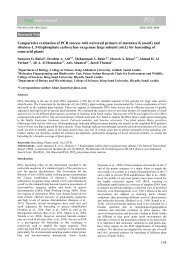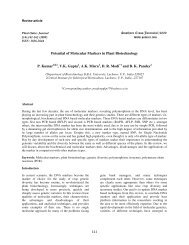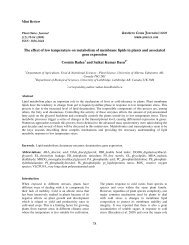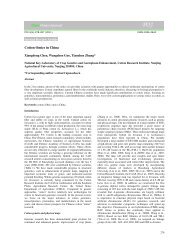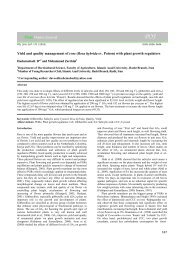Ribulose-1, 5-biphosphate carboxylase (rbcL) gene ... - Plant Omics
Ribulose-1, 5-biphosphate carboxylase (rbcL) gene ... - Plant Omics
Ribulose-1, 5-biphosphate carboxylase (rbcL) gene ... - Plant Omics
You also want an ePaper? Increase the reach of your titles
YUMPU automatically turns print PDFs into web optimized ePapers that Google loves.
Fig 2. The Maximum Likelihood tree showing the relationship of C. graveolens subsp. arabicum with the related taxa. GenBank<br />
accession numbers of the corresponding taxa are written in parentheses. The percentage of replicate trees, in which the associated<br />
taxa clustered together in the bootstrap test (1000 replicates) are shown (>50%) next to the branches. The scale bar represents the<br />
branch length measurement in the number of substitutions per site.<br />
Fig 3. RAPD-PCR products of C. graveolens subsp. arabicum for different primers. M, 100-bp molecular weight marker; P, Ready-<br />
To-Go RAPD analysis primers (GE Healthcare, Buckinghamshire, UK); MW, Molecular Weight.<br />
Agarose gel electrophoresis<br />
A long (20 × 14 cm) 1% agarose gel using 1X TAE buffer<br />
containing 0.5 µg/mL ethidium bromide was used for<br />
electrophoresis of PCR-products. Gel images were obtained<br />
using Proxima C16 Phi+ (Isogen Life Science) UV<br />
transilluminator and Opticom (version 3.2.5; OptiGo)<br />
imaging system. The amplified PCR products were<br />
determined on gel for the presence or absence of the band.<br />
The size of PCR products resulting from the primer pair were<br />
determined by using an Amersham 100-bp ladder (GE<br />
Healthcare) and the TotalLab TL100 1D software (version<br />
2008.01).<br />
Sequencing<br />
Sequences were determined directly using the<br />
dideoxynucleotide chain-termination method with a DNA-<br />
Sequencer (ABI PRISM 3130xl; Applied Biosystems/<br />
Hitachi) and BigDye Terminator (version 3.1) cycle<br />
sequencing kit (RR-100, Applied Biosystems), according to<br />
the manufacturer's instructions. Obtained <strong>rbcL</strong> <strong>gene</strong> sequence<br />
was submitted to DDBJ/EMBL/GenBank database<br />
(Accession no. JQ665721).<br />
Assignment of taxa<br />
BLAST and BOLD searches were applied to the produced<br />
sequence using the available online databases. Sequences of<br />
<strong>rbcL</strong> that matched closely with the query sequences were<br />
retrieved from DDBJ/EMBL/GenBank database. The<br />
sequences were aligned using CLUSTAL X (version 1.81)<br />
(Thompson et al., 1997). Phylo<strong>gene</strong>tic analyses were<br />
conducted in MEGA4 (Tamura et al., 2007). Phylo<strong>gene</strong>tic<br />
trees were constructed using Maximum Likelihood (ML;<br />
Tamura and Nei, 1993), Maximum Parsimony (MP; Nei and<br />
Kumar, 2000) and Neighbor-Joining (NJ; Saitou and Nei,<br />
1987) methods. The topologies of the phylo<strong>gene</strong>tic trees were<br />
evaluated using the bootstrap re-sampling method of<br />
Felsenstein (1985) with 1000 replicates.<br />
RAPD-PCR analysis<br />
Ready-To-Go RAPD analysis beads (GE Healthcare,<br />
Buckinghamshire, UK) were used for RAPD-PCR analysis.<br />
The PCR mixture of 25 µL contained a single Ready-To-Go<br />
RAPD analysis bead, 25 pmol of a single RAPD primer, 50<br />
ng of template DNA and sterile distilled water. The bead<br />
contained thermo-stable polymerase (AmpliTaq DNA<br />
polymerase and Stoffel fragment), dNTPs (0.4 mM each),<br />
288



